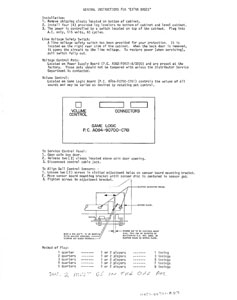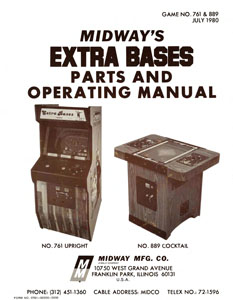




(Based on the Astrocade Chipset)


Documentation relating to the arcade games that are based around the Astrocade chipset. These games include the following:
- Seawolf II (1978)
- Extra Bases (1980)
- Space Zap (1980)
- Wizard of Wor (1980)
- Gorf (1981)
- Robby Roto (1981)
- Demons and Dragons (1982; unreleased prototype)
- Professor Pacman (1983)
- 10 Pin Deluxe (1984; electro-mechanical)
- 10 Pin Champ / Strikes and Spares (1985)
Also included are games that lead directly or indirectly to the development of the custom chips in the Bally Arcade. Such games would include titles such as Midway's 1975 game, Gun Fight.
For more information about these arcade games, see the following:
Arcade Games Based Around Astrocade Chipset
(Bally_Midway)_tn.jpg) |
Adventures of Robby Roto!, The - Parts and Operating Manual By Bally/Midway. June 1982. Table of Contents (Summary)
|
(Stephen Edwards)_tn.jpg) |
Adventures of Robby Roto!, The Reverse Engineering Robby Roto: A 1980s Embedded System Masquerading as an Arcade Game By Stephen Edwards, Columbia University. January 2005. Quoted from the paper's abstract: "Robby Roto was an arcade game produced by Bally/Midway in 1981. Although not especially popular at the time, it does have the distinction of being one of the few commercial arcade games whose code is now in the public domain (the rights reverted to the author Jay [now Jamie] Fenton1, who released it in 1999). Although primitive by today's standards, it is representative of many early arcade games and illustrates a realistic, commercial embedded system. "The description presented here has been synthesized from many sources, including disassembled ROM images; source code from MAME2, the multiple arcade machine emulator by Nicola Salmoria and many others; service manuals; and documentation on the Bally Astrocade home video game system3, which contains many of the same custom chips. "Like many arcade games, Robby was one of a family built with similar hardware. Specifically, it shares its general design with Seawolf II (1978), Space Zap (1980), Extra Bases (1980),Wizard ofWor (1980), Gorf (1981), Professor Pac-Man (1983), and most interestingly, the Bally Astrocade home video game system (1978). All use the same microprocessor, a Zilog Z80, and the same custom graphics and sound chips, which were designed in part by Dave Nutting. For more history of these games and many others, see Herman [2] and Kent [3]." |
 |
Extra Bases - General Instructions By Midway. 1980. General instructions for Extra Bases. One sheet of paper describing in general terms: Installation, Line Voltage Safety Switch, Voltage Control Pots, Volume Control, Service Control Panel and Align Ball Control Sensors. |
(Midway)(Schematics)_tn.jpg) |
Extra Bases - Schematics By Midway. 1980. Four schematics saved in TIFF format. |
 |
Extra Bases - Parts and Operating Manual By Midway. July 1980. Table of Contents:
|
 |
Gorf: Parts & Operating Manual. Midway Mfg. Co. February 1981. Form No. 0873-00300-0000. This document covers the three versions of the arcade game "Gorf" (game #873; upright cabinet, #926; mini cabinet and #927; cocktail cabinet). Included are general instructions, control adjustment procedures, test display procedures, pictures and photographs of cabinets and assemblies, wiring diagrams and component layouts and schematics. Here are a couple of related files:
|
_tn.jpg) |
Gun Fight Computer Service Manual: For the Midway 8080 Microprocessor Game Series, A Comprehensive Analysis of the Gun Fight Game Computer. By Midway Manufacturing Co. 1976. William Arkush Video Game Data Books, Vol. 4. This Gun Fight manual is referenced in the Bally Arcade/Astrocade patent (U.S. Patent 4,296,930, "TV Game Apparatus"). Tony Miller, a hardware engineer who helped create the Bally Professional Arcade, once said that the custom chips in the Astrocade were created from the hardware in such games as Gun Fight. Gun Fight is normally considered the first arcade video game that used a microprocessor (it uses the 8080 CPU). Here is some information from the manual's introduction. Notice how the author's feel the need to explain why they choose to move away from the discrete TTL logic used in former arcade games, such as Western Gun. 1.1.1 Why Use A Microprocessor? The integrated microprocessor (often abbreviated simply as uP) has caused a revolution in the electronics industry for the contemporary uP now makes possible real computers for only a few hundred dollars. Ever since the advent of video games, designers have often wanted to use an actual, general-purpose type computer to operate their games and, in fact, a few custom games have been constructed using fairly powerful minicomputers. But it has never been possible to use such a computer for production video games simply because the cheapest available minicomputers cost thousands, rather than hundreds, of dollars. But today, with microprocessor chips available for $20 and under, systems comparable in power to commercial minis can be built for maybe a tenth of the cost. Obviously the uP is a reality today and is rapidly changing the face of the electronics industry. But what of the reasons designers are so interested in applying them to video games? After all, video games have been successfully manufactured for a number of years using the random-logic type of architecture, so why change now? [...] Now that we have discussed some of the reasons that microprocessors are so quickly gaining in popularity for video games (and a tremendous number of other systems as well), it is time to turn our attention to the specifics of the Gunfight game system. In the following pages, we will discuss the general architecture of the Midway 8080 CPU mother board and the Gunfight game board as well as the specific operation of all phases and components of the system itself. In conclusion, we will present a number of troubleshooting approaches for dealing with specific problems and problematic areas as well as providing a generous amount of actual troubleshooting data so that video game technicians with ordinary troubleshooting equipment will be able to fully explore the circuitry found in this game. This document is originally from the website TokensOnly.com.
|
_tn.jpg) |
Seawolf II Parts Catalog By Midway. 1978. Table of Contents
|
_tn.jpg) |
Seawolf II Schematics By Midway. 1978. This archive includes five schematics for the Seawolf II arcade game released in 1978.
|
 |
Standardized Test Procedure for Midway's Processor Boards. MM 1701-1. By Midway Mfg. Co. (A Bally Company). July 1976. Form-00015-0776. The following is the first page of chapter 1, the introduction to this 55-page manual: The tremendous success of Midway's Gunfight and Sea Wolf games in the coin-operated amusement industry has created a new kind of need. This need has been felt because of the deviation from the usual TTL and the advancement into the Microprocessor (CPU) and the associated circuitry involving RAMS and PROMS. Much has been said and talked about regarding the CPU, RAMS, and PROMS both in the literature and outside, but little has been said or done about troubleshooting a board using these. Hence, this book has been specifically tailored to meet the requirements of troubleshooting Midway's Processor Boards*, (henceforth - referred to as Mother Boards). It does not in any way try to explain how the board works. Throughout the book the major emphasis has been on "How to Fix the Board" and no attempt has been made to describe "How it Works". The Mother Boards used in both the games Gunfight and Sea Wolf are identical except for the Program part. However, to facilitate the writing of this book, reference has been made to the Gunfight game. Substituting "Ship" for "Cowboy" in this book should enable fixing the Sea Wolf games as well. * The turnout percentage of these boards at Midway Mfg. Co. is of the order of 99.7%. This relatively small fall-out is mainly attributed to the manufacturing defects of boards and not the troubleshooting procedures used! |
